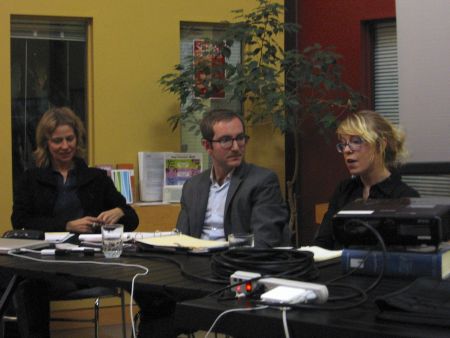JJ Steeves is on the run.
A business owner is chasing her down a Halifax street after she slapped a black and white sticker featuring a cartoon cat saying, “I believe in porn,” on his storefront.
This is the first time she’s gotten close to being caught. With her easily recognizable looks — bright straw hair and even brighter blue glasses — she’s had to learn to paste and sprint. Fast.
Steeves is a street artist.
She’s 27 and her Stray Kitties stickers have graced the electrical poles and building walls of San Francisco, New York City and Miami, Budapest and other cities in Europe, across Canada — and Halifax, where it all started.
Her one-frame cartoons illustrate social issues she encounters every day on the streets of the North End: sexual assault, poverty, poor governance. Born into an upper-class family in Antigonish, she sees it as her responsibility to champion the causes of those less fortunate.
“A lot of voices in this city are being left unheard just because we disregard them,” she says.
“No gallery would take these stories in the same way, nor if I took these stories and put them in a gallery would the people who they are about go to them.”
So, she uses the street as her gallery — and risks being chased down by business owners or, worse, the police.
Steeves is open about the illegality of her work. Stray Kitties are stamped with the pseudonym JEI, which is publicly advertised on her website. She also has other tag names — ones plastered next to her spray-painted stencil work — that she’d rather you not know about.
“It’s way more fun to put art in the street than it is to put in a gallery — not to say I’ll never work in a gallery; I just don’t seek it out. And right now, I don’t have anything that could go in a gallery,” she laughs, “unless they’d let me cover their walls with stickers and skateboards.”
Her aversion to galleries began during her time at Mount Allison University, when a mentor made the “damning statement” that as a working artist, she’d spend more time applying for grants than making artwork.
Gallery art was out; street art was in.
“I’d always been really interested in street art and so I thought a good way to ease myself in was with making stickers,” she says.“Eventually, Stray Kitties sort of burst through a desire to make something, put it out there and have no control over what happens after that.”
It’s a desire shared by public artists — illegal and not.
Kim Morgan is a multimedia artist and instructor at NSCAD University.
While she says she does not promote illegal art, her own work has “surfed the boundaries around public and private issues.”
Her projects Time Transit and Data S p a c e d used audio and video surveillance on Regina buses and in University of Regina hallways to create public art that engages transit users and passersby without their
permission.
Jose Andres Mora likes to rope people into his artwork, too.
The Halifax-based artist says he enjoys artwork that plays with people’s expectations of what a public space is or how it is used.
He installed a screen during this fall’s Nocturne art festival featuring an elevator door that would only open when someone approached.
“I think one of the strongest things (public art) can do is create an awareness of a space that you probably didn’t have before,” he says.
But what if the artwork breaks the law?
On Nov. 19, Mora, Morgan and Steeves participated in a discussion on Public Interventions and Illegal Art hosted by Visual Arts Nova Scotia.
They shared their interpretations of public art and bounced their ideas off Daniel Pink, a local lawyer and art enthusiast.
Pink is one of the founders of the Artists Legal Information Society, a group of lawyers and law students that provides law workshops, one-on-one clinics and online legal information to artists.
He says a few legal issues come into play when it comes to public art, like copyright and intellectual property rights: something many public artists like Morgan have no choice but to forfeit when signing contracts for municipal art pieces or collaborative projects.
And the possible ramifications of illegal art are clear.
Artists like Steeves face being charged with mischief under the Criminal Code, which can lead to jail time or, more likely, a fine, community service and probation. And HRM also has a zero tolerance policy for graffiti.
Steeves counts herself lucky she’s never been caught.
Still, the potential for arrest hasn’t turned off many young Halifax artists.
Whether it’s the assignments of Morgan’s students — which she insists are legal or, at least, non-permanent — or Steeves’s street art peers, Halifax is seeing a public art renaissance.
Look out for it, says Steeves.
“The more you start thinking about street art, the more you notice it."
This story was originally published in the Halifax Commoner.



